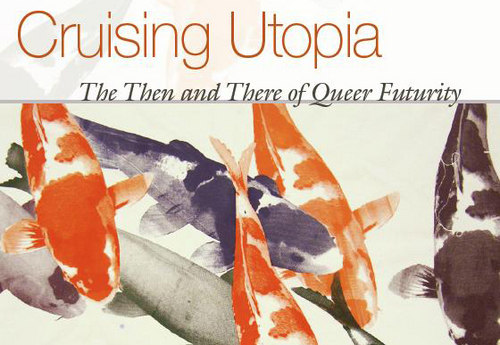By
José Esteban Muñoz
June 19, 2010
Tags queer aesthetics, queer theory, utopia
These responses to Cruising Utopia: The Then and There of Queer Futurity situate the project in extremely valuable and useful ways. These readers are all ideal for me: thus indicating my sense of ideality as incalculable and expansive. In each of these generous engagements with the book, the respondent speaks to aspects of my project that I most hoped would be noticed, taken up and hopefully, productively used.
Gayatri Gopinath thoughtfully contextualizes the work in relation to
my first book and the project of queer of color critique. While
Cruising Utopia is not a book exclusively about queers of color, it is meant to be a performance of a queer of color critique that displaces static notions of subjectivity. This approach is in the spirit of performance studies’ emphasis on performativity (doing) over epistemology (meaning). Gopinath identifies this work as the experiment of attempting to think through the project of performing impossibility in the face of the pragmatic. More locally, my long-time colleague Barbara Browning thinks about the writing project in relation to the pedagogical and larger relational sphere that encompasses our shared post-disciplinary project. She succinctly describes one of the project’s main archiving impulse as the desire to write about loved objects. Ricardo Ortiz reads the work within the philosophical grain it attempts to traverse. He hears my attempt to open the text in “full song” and responds with his distinct theoretical eloquence. Lauren Berlant is also incredibly sensitive to my most accented points of argumentation. She hones in on the book’s subtitle. Berlant comprehends the essential formulation as an attempt to enact a feeling of futurity in the face of what some many of us experience as a “negating present.” The idea here is not to dismiss the present as a lost cause; indeed futurity is more than anything a figurative move calibrated to offer the reader an expanded sense of the present and the possible.
Finally, my dear friend Vaginal Davis’s drawing of Fred Herko graphically conveys what my attachment to the tragic and beautiful luminosity of the dancer and all the things his work promised in its felicity and infelicity. In Herko I found the power and potential of failure as transformative aesthetic and political force, and Davis’ commissioned piece joyously cuts to the chase of that particular observation.
Cruising Utopia imagines another way of reading and thinking about queer desire and being in the world. My work does not strike the pose of being “about life and death.” This is to acknowledge that it is unapologetically about aesthetics and, subsequently, that it understand that the relationship between politics and aesthetics is immediate and integral. The intentions, aims and hopes that propel this project is a belief that I write from a time that is no longer here, in the hopes that these words will be potentially instructive to a not yet here. I write with the animating glow of philosophical idealism, and I articulate my thought through descriptions of performances of queer aesthetics practiced in everyday life, literature and art. Cruising Utopia is a book that longs for collectivity during moments of escalating political isolation. It is my hope that Cruising Utopia offers readers resources that will help us belong to a future that is often narrated as impossible but is nonetheless attainable and utterly necessary.


